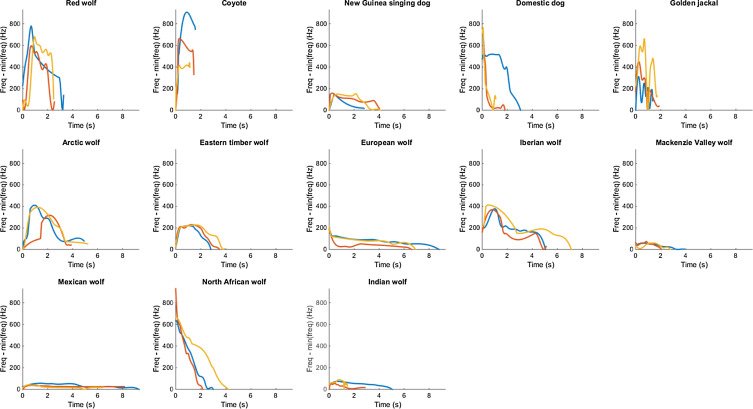
Publications
Core Peer Reviewed Publications
-

Not afraid of the big bad wolf: Calls from large predators do not silence mesopredators
H Root‐Gutteridge, BR Smith, A Kershenbaum, H Butkiewicz, AC Fontaine, JL Owens, L Schindler, A DassowWildlife Biology (2024), e01226
-

Combining acoustic localization and high-resolution land cover classification to study predator vocalization behaviour
E Bru, BR Smith, H Butkiewicz, AC Fontaine, A Dassow, JL Owens, H Root-Gutteridge, L Schindler, A Kershenbaum
Wildlife Research (2023), 50 (12), 965-979
-

Acoustic localisation of wildlife with low-cost equipment: lower sensitivity, but no loss of precision Item
BR Smith, H Root-Gutteridge, H Butkiewicz, A Dassow, AC Fontaine, A Markham, JL Owens, L Schindler, M Wijers, Arik Kershenbaum
Wildlife Research (2021) 49 (4), 372-381
-

Tracking cryptic animals using multilateration: A system for long range wolf detection
A Kershenbaum, JL Owens, S Waller
The Journal of the Acoustical Society of America (2019), 145 (3), 1619-1628 -

Disentangling canid howls across multiple species and subspecies: Structure in a complex communication channel
A Kershenbaun, H Root-Gutteridge, B Habib, J Koler-Matnick, B Mitchell, V Palacios, S Waller
Behavioural Processes (2016), vol. 124, pp. 149-157
Popular science books
-

Why Animals Talk: The New Science of Animal Communication
Arik Kershenbaum
Penguin, 2024
-

The Zoologist's Guide to the Galaxy: What Animals on Earth Reveal about Aliens--and Ourselves
A Kershenbaum
Penguin, 2021
Selected additional scientific publications
-
A multifaceted framework to establish the presence of meaning in non‐human communication
J Amphaeris, DT Blumstein, G Shannon, T Tenbrink, A Kershenbaum
Biological Reviews (2023) 98 (6), 1887-1909
-
Genetic distance from wolves affects family dogs’ reactions towards howls
F Lehoczki, A Andics, A Kershenbaum, E Kubinyi, D Passilongo, H Root-Gutteridge, F Range, V Palacios Sanchez, L Schmidt, SW Townsend, SK Watson, T Farago
Communications Biology (2023) 6 (1), 129
-
A collection of best practices for the collection and analysis of bioacoustic data
J Oswald, AM Van Cise, A Dassow, T Elliott, MT. Johnson, A Ravignani, J Podos. Applied Sciences 12, no. 23 (2022): 12046.
-
Bioacoustic Detection of Wolves: Identifying Subspecies and Individuals by Howls
HL Larsen, C Pertoldi, N Madsen, E Randi, A Vik Stronen, H Root-Gutteridge, S Pagh
Animals (2022), 12(5), 631.
-
Shannon entropy as a robust estimator of Zipf's Law in animal vocal communication repertoires
A Kershenbaum, V Demartsev, DE Gammon, E Geffen, MLGustison, A Ilany, AR Lameira
Methods in Ecology and Evolution (2021) 12 (3), 553-564
-
Identifying unknown Indian wolves by their distinctive howls: its potential as a non-invasive survey method
S Sahukhan, H Root-Gutteridge, B Habib
Scientific Reports (2021), 11, article number 7309.
-
The ecological effects of livestock guarding dogs (LGDs) on target and non-target wildlife
BR Smith, RW. Yarnell, A Uzal, and K Whitehouse-Tedd
Journal of Vertebrate Biology (2020) 69, no. 3: 20103-1.
-
Acoustic Identification of Wild Gray Wolves, Canis lupus, Using Low Quality Recordings.
C Hull, CM McCombe, A Dassow. American Journal of Undergraduate Research 16, no. 4 (2020).
-
A lifetime of changing calls: North Atlantic right whales, Eubalaena glacial, refine call production as they age
H Root-Gutteridge, DA Cusano, Yu Shiu, DP Nowacek, SM Van Parijs, SE ParksAnimal Behaviour (2018), 137, pp. 21-34.
-
Measuring acoustic complexity in continuously varying signals: how complex is a wolf howl?
Arik Kershenbaum, Éloïse C Déaux, Bilal Habib, Brian Mitchell, Vicente Palacios, Holly Root-Gutteridge, Sara Waller
Bioacoustics 27, no. 3 (2018): 215-229.
-
Howl variation across Himalayan, North African, Indian, and Holarctic wolf clades: Tracing divergence in the world's oldest lineages using acoustics
L Hennelly, B Habib, H Root-Gutteridge, V Palacios, D Passilongo
Current Zoology (2017), 63(3): 341-348
-
Calls of North Atlantic right whales Eubalaena glacialis contain information on individual identity and age class
JA McCordic, H Root-Gutteridge, DA Cusano, SL Denes, SE Parks
Endangered Species Research (2016) 30:156-169.
-
Acoustic sequences in non‐human animals: a tutorial review and prospectus
Kershenbaum, Arik, Daniel T. Blumstein, Marie A. Roch, Çağlar Akçay, Gregory Backus, Mark A. Bee, Kirsten Bohn et al.
Biological Reviews 91, no. 1 (2016): 13-52.
-
Improving individual identification in captive Eastern grey wolves (Canis lupus lycaon) using the time course of howl amplitudes
H Root-Gutteridge, M Bencsik, M Chebli, LK Gentle, C Terrell-Nield, A Bourit, RW Yarnell
Bioacoustics (2014), 23(1), 39–54.
-
Identifying individual wild Eastern grey wolves (Canis lupus lycaon) using fundamental frequency and amplitude of howls
H Root-Gutteridge, M Bencsik, M Chebli, LK Gentle, C Terrell-Nield, A Bourit, RW Yarnell
Bioacoustics (2014), 23(1), 55–66.
-
Animal vocal sequences: not the Markov chains we thought they were
A Kershenbaum, AE Bowles, TM Freeberg, DZ Jin, AR Lameira, K Bohn
Proceedings of the Royal Society B: Biological Sciences 281 (1792), 20141370
-
The encoding of individual identity in dolphin signature whistles: How much information is needed?
A Kershenbaum, LS Sayigh, VM Janik
PloS One (2013) 8 (10), e77671
-
Syntactic structure and geographical dialects in the songs of male rock hyraxes
A Kershenbaum, A Ilany, L Blaustein, E Geffen
Proceedings of the Royal Society B: Biological Sciences (2012)